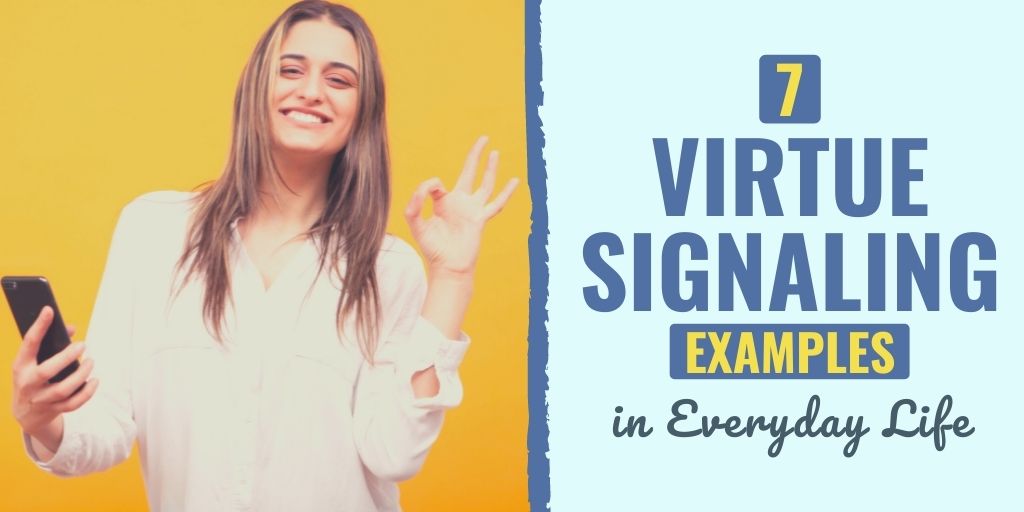There might be affiliate links on this page, which means we get a small commission of anything you buy. As an Amazon Associate we earn from qualifying purchases. Please do your own research before making any online purchase.
Did you participate in the celebrated ice bucket challenge of 2014?
If so, do you remember what it was for?
And if you do, do you know what “ALS” stands for?
If you did participate in the ice bucket challenge, you probably felt like you were doing something for a good cause. However, if you’re completely unfamiliar with amyotrophic lateral sclerosis, you may be put into a category of people who were “virtue signaling”.
Now, is this a good thing or a bad thing? Or a bit of both?
In this article, we are going to explore what virtue signaling means and analyze its significance in today’s culture of social media. Finally, we will see how you can respond to this sort of behavior.
Let’s start by taking a look at what this phenomenon is.
What is Virtue Signaling?
In our world of effortless retweeting of opinions, it's never been so easy to showcase your thoughts; however, the effort required to actually do something to make a difference hasn’t changed. You can “like” posts on social media all day or even write your own rant for others to support, but doing so won’t make a measurable change in the cause at hand.
This easy access to public complaining has increased the gap between preaching and actually practicing what you believe, which is precisely the space in which hypocrisy lives.
Virtue signaling, in its most basic form, describes when someone flaunts their views to make themselves look good in front of people they want to impress. And while declaring your values is a good thing, it doesn’t become so great when the things you say completely replace any action you could take to reach a solution.
The defining characteristic of virtue signaling is its goal of demonstrating one’s good moral values, although these values are seen as insincere and not representative of one’s true thoughts or beliefs, which doesn’t result in a significant positive outcome.
This is also known as “slacktivism”–which points to the fact that it’s much easier to change your profile picture to support a cause than it is to engage in actual activist activities.
However, virtual signaling isn’t always bad, per se. A positive outcome may result from virtue signaling, regardless of whether or not it’s genuine. In the case of the ice bucket challenge, this movement led to $115 million for the ALS Association, which made an undeniable difference, even if the motivation behind people’s actions was to make sure others believed they cared about the cause.
Although the idea of virtue signaling has been around since biblical times, the term experienced a resurgence of popularity following the 2014 social phenomenon of the ice bucket challenge and has since become a common term when talking about fallacies.

Let’s take a look at some other examples of virtue signaling that we come across in everyday life.
7 Virtue Signaling Examples in Everyday Life
1. Blackout Tuesday
Blackout Tuesday involved people changing their profile picture on social media to a solid black square. The collective action, which occurred on June 2, 2020, was intended to combat police brutality in response to several unjust killings of black people by police officers in recent history. Some incidents of this included the killings of George Floyd, Sandra Bland, Breonna Taylor, Eric Garner, Tamir Rice, Michael Brown, and Tony McDade.
Blackout Tuesday was criticized as being virtue signaling because the trend didn’t move people to take action–it merely showcased people’s apparent support for the cause on social media. As a form of passive activism, those who participated in Blackout Tuesday may have been jumping on the bandwagon to conform with society, which removes the genuine notion of trying to make a change.
2. Black Lives Matter
The Black Lives Matter movement is often associated with virtue signaling. White people with privileged backgrounds express their support for the BLM movement by creating and liking posts on social media that indicate their solidarity with this cause, attempting to prove they’re virtuous, which–in this case–means they don’t discriminate against minorities. They may have a perception that they’re among the “good” white people rather than those who are racist, and by signaling their virtue on social media, they’re letting others know which group they fall into.
This strategy is criticized because while people are trying to promote equality, their activity on social media is more of an arrogant attempt to portray themselves in a certain light. People with a privileged background might show their support for Black Lives Matter online, but what actions are they taking to support the values they’re endorsing?
Actually working toward a just society is a big jump from virtue signaling through a social media post, and many people don’t put forth the effort to take those extra steps.
3. Kony 2012
Kony 2012 is a short documentary whose purpose was to make Joseph Kony, an international criminal fugitive, recognized around the world in order to have him detained by the time the campaign expired at the end of the year.
The video soon went viral, capturing the attention of celebrities and attracting over 18.6 million views on YouTube. The video quickly became the “most liked” YouTube video and the first video to reach one million “likes” in the site’s history.
Since its release, the organization that created the video, Invisible Children Inc., has been criticized for virtue signaling by oversimplifying genocide in Africa at the hands of Joseph Kony. Critics note that the campaign has no real effect as people on social media only take the action of liking or commenting on a post, which has little impact beyond making people feel like they’ve contributed to the cause in some way.
4. COVID-19 Marketing Messages
The hot topic of today is the COVID pandemic, and companies aren’t passing up on the opportunity to demonstrate their virtue. But companies don’t stop at communicating to consumers that they’re taking precautions during the pandemic–they’re sending out coronavirus-themed emails to detail exactly how they’re keeping their employees safe while trying to continue doing business through this unprecedented time.
And the email stops there.
But why is it necessary for any company to let consumers know that they care about the wellbeing of their employees? Wouldn’t you assume that to be true of any business?

This type of marketing material that signals a brand's virtue without taking any action can actually hurt a company’s bottom line because they’ve just wasted their customers’ time by filling up their inboxes without offering anything meaningful.
The “important messages” that are being sent from businesses during this health crisis aren’t what one might expect, such as giving customers helpful information about things they can do if they’re not able to pay their bills due to being laid off because of COVID. And, without any content to help customers, this egocentric virtue-signaling is made much more obvious to the public.
5. Responding to Tragedy
Celebrities, politicians, and businesses often use social media to respond to tragedies and show the public their outrage against injustice. For example, in response to the San Bernadino terrorist attack in 2015, Mark Zuckerberg posted his exasperation on Facebook, announcing that he will continue to do what he has always done–not ban Muslims on his social networking site.
Another example of this is when Emma Thompson spoke out on social media about how the U.K. needs to house more refugees, and in not doing so, the U.K. is racist. However, similar to other British citizens who share this stance, Thompson has not been seen housing any refugees in her own home. These celebrities show that while they believe the rest of the country needs to take in refugee families, they shouldn’t house any refugee families themselves.
6. “Thoughts and Prayers”
Sending thoughts and prayers to victims of recent events is a popular move to make on social media. However, doing so accomplishes nothing and incites no real change in the matter at hand.
Writing “thoughts and prayers” in response to something terrible happening in the world doesn’t require time, compassion, or money. It simply attaches one’s name in a public space to the act of caring for others, when in reality, do these same people donate their time or money after mass shootings, reach out to politicians about gun laws and mental healthcare in America?
Here, virtue signaling is the line between actually taking action and just wanting people to think you’re making a difference.
7. Marketing
Even companies use virtue signaling to lure in consumers to supporting their brand. The term itself was associated with Whole Foods’ 2015 advertising claim, “We are part of a growing consciousness that is bigger than food — one that champions what’s good.”
Here, the company is indicating to others that they’re virtuous, wholesome, and kind. However, does the company have a track record of acting accordingly? Or is this a newfound stance that’s being used in an attempt to align with a seismic movement in the collective opinion of society?
It can feel deceitful when a newly-enlightened company jumps on board with the public’s changing values.
Read More About Other Logical Fallacies
- 5 Appeal to Nature Fallacy Examples in Media and Life
- 6 Outcome Bias Examples That Can Negatively Impact Your Decisions
- 7 Self-Serving Bias Examples You See Throughout Life
- 7 Omission Bias Examples That Negatively Impact Your Life
- 6 Authority Bias Examples That Might Impact Your Decisions
- 5 Burden of Proof Fallacy Examples
- 5 Appeal to Tradition Fallacy Examples in Life
- 5 Appeal to Authority Logical Fallacy Examples
- 7 False Cause Fallacy Examples
- 7 Appeal to Ignorance Fallacy Examples
- 7 Appeal to Common Sense Logical Fallacy Examples
- 5 Post Hoc Fallacy Examples (and How to Respond to This Argument)
- Gambler’s Fallacy: 5 Examples and How to Avoid It
- 5 Appeal to Anger Fallacy Examples Throughout Life
- 7 Halo Effect Bias Examples in Your Daily Life
- 7 Poisoning the Well Examples Throughout Your Life
- 7 Survivorship Bias Examples You See in the Real World
- 7 Dunning Kruger Effect Examples in Your Life
- 7 Either Or (“False Dilemma”) Fallacy Examples in Real Life
- 5 Cui Bono Fallacy Examples to Find Out “Who Will Benefit”
- 6 Anchoring Bias Examples That Impact Your Decisions
- 7 Cherry Picking Fallacy Examples for When People Ignore Evidence
- 9 Circular Reasoning Examples (or “Begging the Question”) in Everyday Life
- 9 Appeal to Emotion Logical Fallacy Examples
- 9 Appeal to Pity Fallacy (“Ad Misericordiam”) Examples in Everyday Life
- 9 Loaded Question Fallacy Examples in Life and Media
- 9 Confirmation Bias Fallacy Examples In Everyday Life
- 9 Bandwagon Fallacy Examples to Prevent Poor Decisions
- 5 Red Herring Fallacy Examples to Fight Irrelevant Information
- 9 Middle Ground Fallacy Examples to Spot During an Argument
- 5 False Equivalence Examples to Know Before Your Next Argument
- 7 Hasty Generalization Fallacy Examples & How to Respond to Them
- 6 Straw Man Fallacy Examples & How You Can Respond
- 6 False Dichotomy Examples & How to Counter Them
- 7 Slippery Slope Fallacy Examples (And How to Counter Them)
- What is the Planning Fallacy?
- How to Overcome the “Sunk Cost Fallacy” Mindset
Final Thoughts on Virtue Signaling
Virtue signaling is mainly motivated by a desire to showcase one’s positive moral values, with little regard to whether it actually leads to a positive change or not. But, as a social media onlooker, you can never truly know what someone’s motivations are behind a post or what type of activism they’re participating in.
By knowing about virtue signaling, you can take personal responsibility to take action on issues that you believe merit more than a “like” on social media. So rather than accusing other people of engaging in this fallacy, be more aware of your own actions (or inactions) to avoid being rightfully accused of virtue signaling yourself.
Finally, if you want a simple process to counter the logical fallacies and cognitive biases you encounter in life, then follow this 7-step process to develop the critical thinking skills habit.

Connie Mathers is a professional editor and freelance writer. She holds a Bachelor's Degree in Marketing and a Master’s Degree in Social Work. When she is not writing, Connie is either spending time with her daughter and two dogs, running, or working at her full-time job as a social worker in Richmond, VA.


